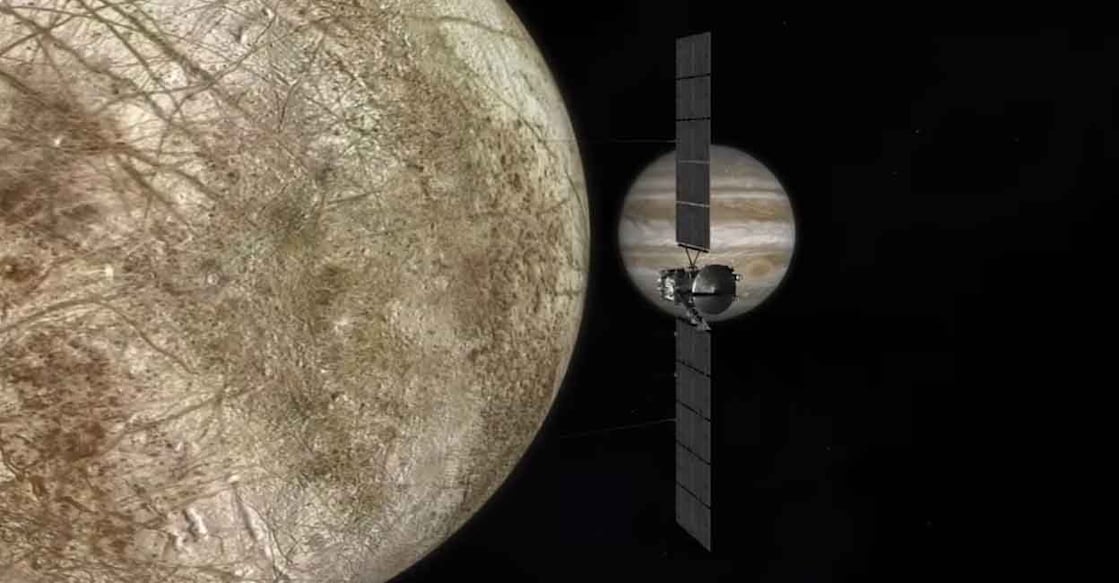Explained | NASA’s Europa Clipper Mission

Mail This Article
• NASA’s Europa Clipper mission is scheduled for launch on October 10 aboard a SpaceX Falcon Heavy rocket. NASA approved the launch of the mission to study Jupiter’s moon, Europa, after reviewing the spacecraft’s ability to withstand the intense radiation there.
• This $5 billion mission will explore Jupiter’s moon, Europa, with the goal of determining if the moon’s sub-surface ocean could support life.
• It will take six years for Europa Clipper to reach Jupiter, where it will orbit the gas giant every three weeks. Dozens of flybys are planned of Europa as close as 25 kilometers, allowing cameras and other instruments to map virtually the entire moon.
• Europa Clipper, with its massive solar arrays and radar antennas, is the largest spacecraft NASA has ever developed for a planetary mission. With its arrays deployed, the spacecraft spans more than 100 feet (30.5 meters).
What is Europa?
• Europa is the smallest of the four largest moons orbiting Jupiter (including Io, Ganymede, and Callisto), and the sixth-closest to the planet of all the 79 moons of Jupiter.
• Europa was discovered in 1610 by Galileo Galilei. The German astronomer Simon Marius claimed to have observed Jupiter’s moons at about the same time as Galileo, and is commonly credited as being the co-discoverer of the moons.
• The moon was named after Europa, the Phoenician mother of King Minos of Crete, with whom Zeus (the Greek equivalent of the Roman god Jupiter) fell in love.
• With an equatorial diameter of 3,100 kilometers, Europa is about 90 per cent the size of Earth’s Moon.
• Slightly smaller than Earth’s Moon, Europa is primarily made of silicate rock and has a water-ice crust and probably an iron-nickel core. It has a very thin atmosphere, composed primarily of oxygen. Its surface is striated by cracks and streaks, but craters are relatively few.
• Scientists are almost certain that hidden beneath the icy surface of Europa is a saltwater ocean containing about twice as much water as Earth’s global ocean.
• It may be the most promising place in our solar system to find present-day environments suitable for some form of life beyond Earth.
The purpose of NASA’s Europa Clipper mission
• NASA’s Europa Clipper spacecraft will conduct a detailed survey of Jupiter’s moon Europa to determine whether there are places below the surface that could support life.
• The spacecraft, in orbit around Jupiter, will make about 40 to 50 close passes over Europa, shifting its flight path for each flyby to soar over a different location so that it eventually scans nearly the entire moon.
• During the prime mission, the spacecraft will perform flybys of Europa at closest-approach altitudes as low as 25 kilometers above the surface.
• It will gather detailed measurements to investigate whether the moon could have conditions suitable for life.
• Europa Clipper is not a life detection mission. Its main science goal is to determine whether there are places below Europa’s surface that could support life.
• The spacecraft has large solar arrays to collect enough light for its power needs as it operates in the Jupiter system, which is more than five times as far from the Sun as Earth.
Science instruments for the mission
• The mission’s three main science objectives are to understand the nature of the ice shell and the ocean beneath it, along with the moon’s composition and geology.
• NASA has selected nine science instruments for the mission. The selected payload includes cameras and spectrometers to produce high-resolution images of Europa's surface and determine its composition.
• An ice-penetrating radar will search for sub-surface lakes similar to those beneath Antarctica’s ice sheet. The mission will also carry a magnetometer and a plasma instrument to measure the strength and direction of the moon's induced magnetic field, which will allow scientists to confirm the existence of Europa’s sub-surface ocean and determine its characteristics (e.g., depth and salinity).
• Contributions from multiple instruments will help constrain ice shell thickness. A thermal instrument will survey Europa’s frozen surface in search of recent eruptions of warmer water at or near the surface.
• Additional instruments will characterise the composition of gases and tiny particles in the moon's thin atmosphere – and search for potential plumes of water vapor that might erupt from the moon’s surface.
• Because Europa is bathed in radiation trapped in Jupiter’s magnetic field, Europa Clipper’s payload and other electronics will be enclosed in a thick-walled vault. This strategy of armoring up to go to Jupiter with a radiation vault was developed and successfully used for the first time by NASA’s Juno spacecraft.
• The vault walls — made of titanium and aluminum — will act as a radiation shield against most of the high-energy atomic particles, dramatically slowing down degradation of the spacecraft’s electronics.




